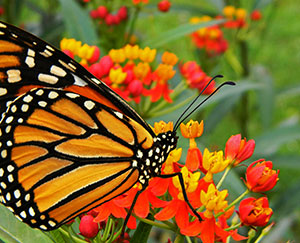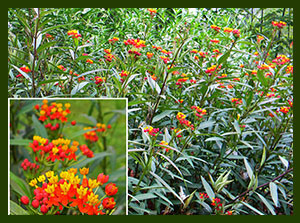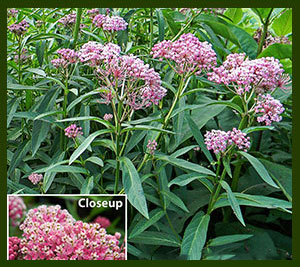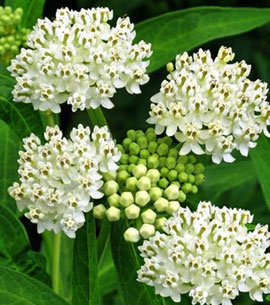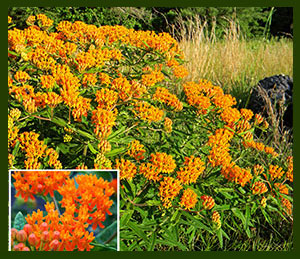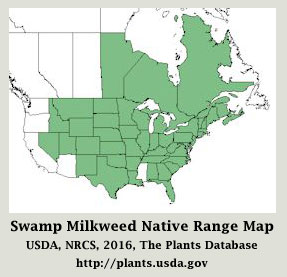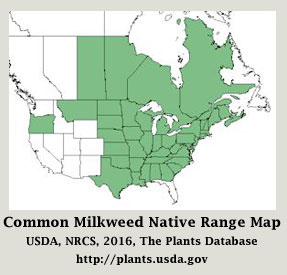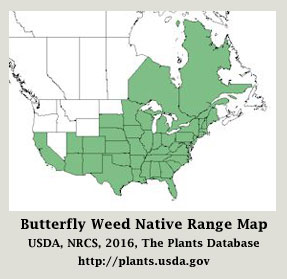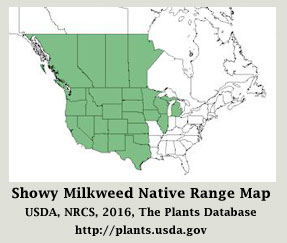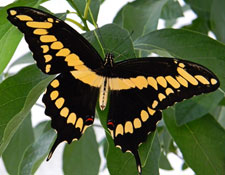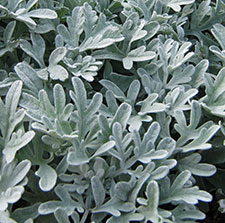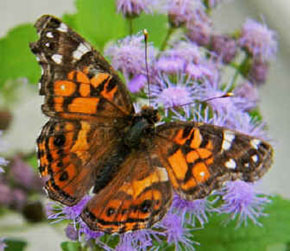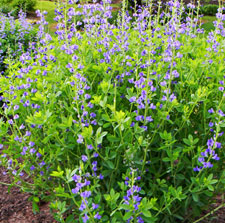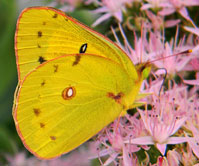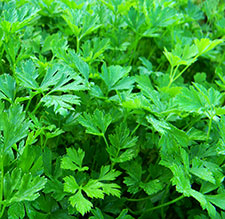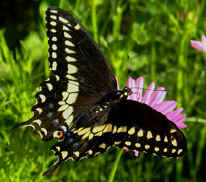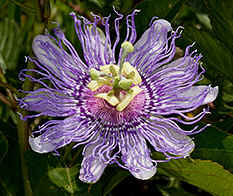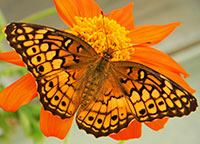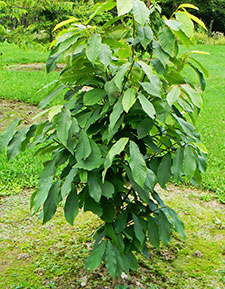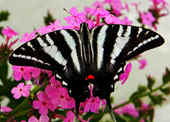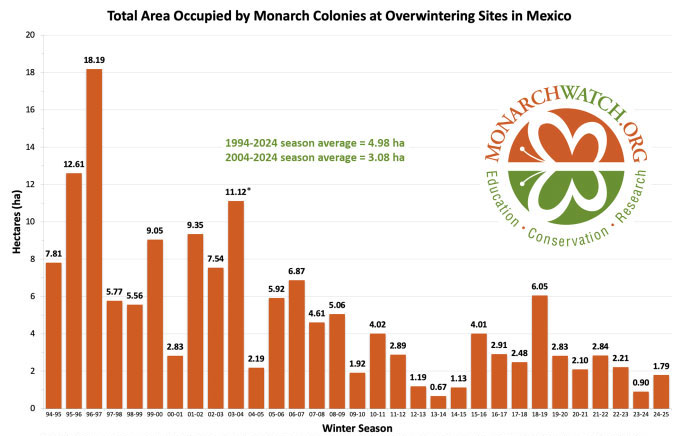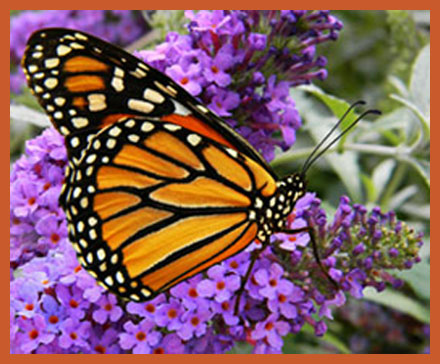Which
Milkweed for the Monarchs?
by Rose Franklin, January 19, 2015
Americans are worried about the current status of the
Monarch butterfly population, and they should be. Monarch numbers have
dramatically declined in the past ten years or so. Some entomologists even
wonder if the spectacular annual migration to and from Mexico might one
day cease to exist. The over-wintering population in Mexico last winter,
2013-2014, was the smallest ever recorded, about 10% of the 20-year
average.
Monarch enthusiasts, knowing that Monarchs must have
access to milkweed if the population is to increase, are opting to plant
milkweed instead of petunias, impatiens, geraniums, and marigolds. But
they are confused about which milkweed species they should plant. Some
gardeners are told they should only plant the milkweed species that are
native to their area while others hear that almost any milkweed, including
those that grow in the tropic jungles of the world, like Tropical Milkweed
(Asclepias curassavica), are suitable hosts for the Monarch.
It was scientists who first began to oppose the
planting of Tropical Milkweed. They claimed that because this milkweed
species grows year around in some parts of the U.S, it might disrupt the
Monarchís migratory cues in autumn and facilitate in the creation of a
large population that does not migrate but, instead, resides year around
where Tropical Milkweed grows year around. And
there, where it is not killed off annually by autumn frosts (southern
Florida and along the coastal region of the Gulf of Mexico), Tropical
Milkweed surely harbors pathogens and facilitates in the increased
transmission of disease (especially Oe, Ophryocystis elektroscirrha).
Researchers even know that there are, and have been for a number of years,
a few small Monarch populations residing year around, and breeding year
around, in isolated locations along the Gulf coast.
Migration
likely serves several purposes in the well-being of Monarchs. It compels
the Monarch to abandon habitat which might be contaminated with pathogens.
The long-distance migration also serves to weed out the individuals that
are weak and diseased, so that only the healthiest of the population is
left to produce offspring the following year.
Because
migration is assuredly advantageous to the health of the Monarch
population, I am not comfortable in knowing that even a tiny fragment of
the Monarch population has become non-migratory and now breeds year around
in a few locations along the southern coast of the U.S. In those areas
where Tropical Milkweed does not die in winter, I urge people to refrain
from planting it. If it is already planted, I suggest the
Tropical Milkweed plants be cut to the ground in autumn and all the debris
discarded, thus eliminating the
possibility of Monarchs reproducing year around on foliage which might be
contaminated with disease. If those residents along the Gulf coast are unwilling or
unable to cut their plants to the ground every fall, I advise them to spray
their Tropical Milkweed with Roundup, repeatedly until it is completely gone. I donít
generally advocate the use of Roundup, but in this case, I will tolerate
its use so that the Monarch will be able to multiply in healthy, disease-free
environments.
OK. I agree that in the
2% of the nation where
Tropical Milkweed grows year around, it could, and most likely does,
harbor and spread disease among the small Monarch population that has
chosen to reside and breed there year around. But, as
stated above, this could be prevented if people would cut their Tropical
Milkweed plants to the ground every fall. In the other 97% of the U.S.
though, I think Tropical Milkweed might well be of benefit to the Monarch,
especially at this point in time, when Monarch numbers are swiftly
dwindling (though, in my opinion, maybe not any faster than other
butterfly species are dwindling in number).
I do not believe that Monarchs migrating from eastern
Canada or the northeastern states of the U.S to Mexico could be persuaded
to stay in Pennsylvania or Virginia because they encounter a large stand
of Tropical Milkweed growing in a garden. I simply do not believe that.
Eastern Monarchs are genetically programmed to make the annual migration
to the over-wintering sites in the high-altitude oyamel fir forests in the
trans-volcanic mountains of central Mexico. Northeastern Monarchs emerging
from pupae between late August and mid-September are in reproductive
diapause and thus, not even capable of mating and laying eggs. Probably in
response to shorter day length, cooler autumn temperatures, and/or the
orientation of the sun, they emerge from their pupae, feed on nectar to
store sugar in their bodies, and then automatically begin their long
journey south.
I have been an avid butterfly gardener for
over twenty
years, and I have grown many species of milkweed in my gardens in central
Pennsylvania. My advice, at this particular point in time, is to plant
whatever milkweed species will aid the Monarch in its quest to survive and
multiply.
Several years ago, I might have agreed with those who
advocate the planting of natives only. Today though, with the Monarch
numbers at an all-time low, I advocate that we plant whichever milkweed
species Monarchs will readily lay eggs on, and/or whatever milkweed
species Monarch caterpillars will readily feed on.
Having had many milkweed species our my yard over the
past two decades, my husband and I have seen that, consistently from one
year to the next, female Monarchs lay more eggs on Tropical Milkweed (Asclepias curassavica) than they do on any other milkweed species.
Annually, we find 300 or more Monarch caterpillars on the hundreds of
milkweed plants growing on our property. At least 70% of those are found
feeding on the Tropical Milkweed, not the Pennsylvania native Common
Milkweed (Asclepias syriaca),
Swamp Milkweed (Asclepias incarnata),
or Butterfly Weed (Asclepias
tuberosa).
Tropical Milkweed (Asclepias
curassavica), also known as Bloodflower, grows 36Ē to 48Ē high,
generally blooms from mid-July through frost, and prefers full sun. It is
native to tropical South America, Mexico, Central America, and a few torrid islands
in the Caribbean and thus, must be treated as an annual
in most of the U.S. Tropical Milkweed produces clusters of tiny,
star-shaped flowers which might be yellow, yellow/orange, or red/orange
bi-colors.
I have to assume that female Monarchs know what they
are doing in choosing Tropical Milkweed for the laying of their eggs. If
they intrinsically choose to lay eggs on Tropical Milkweed, even when a
number of native species are available to them, they must have innate
reasoning for doing so. Monarchs are genetically programmed to halt
reproduction in fall, inherently wired to make the annual migration to and
from Mexico, and I think, innately programmed to know which milkweed
species is best suited for their offspring to consume. Maybe Tropical
Milkweed is more nutritious than native milkweeds, maybe it has a higher amount of cardenolides in it, which, once consumed by the
caterpillars, serve to make both the caterpillars and the adult
butterflies toxic to birds.
Andy, my husband, and I offer a huge buffet of
milkweeds to the Monarchs that visit our property during the summer
months. Having a choice of depositing eggs on the hundreds of Common
Milkweed, Swamp Milkweed, and Butterfly Weed which grow in our yard, along
with other milkweeds too, they overwhelming choose Tropical Milkweed. I
donít know why they choose it, and I donít care why. I only know that
they do.
Aside from advocating the planting of Tropical
Milkweed because female Monarchs prefer it for egg-laying, I promote it
for another reason also. Tropical Milkweed is highly utilized as a nectar
source by fall-migrating Monarchs. In October, when Monarchs are still
migrating through Pennsylvania and most flowering plants are far past
their prime, Tropical Milkweed is generally still green and, apparently,
still producing sweet-flavored nectar. On warm, sunny October days, from
late morning through mid-afternoon, our Tropical Milkweed patches are
adorned by the flutter of dozens of migrating Monarchs. They stop by,
nectar for just a while, and then continue on their way.
Monarchs are in crisis--and so long as they are, and
unless someone convinces me that Tropical Milkweed is causing peril to the
Monarch (other than in that 2% of the country where it does not freeze out
over the winter), I will continue to promote the planting of Tropical
Milkweed. I love the Monarch, and my wish is that its population rebounds
to the number recorded in Mexico during the winter of 1996-1997, the year
the Monarch count was the highest ever recorded.
